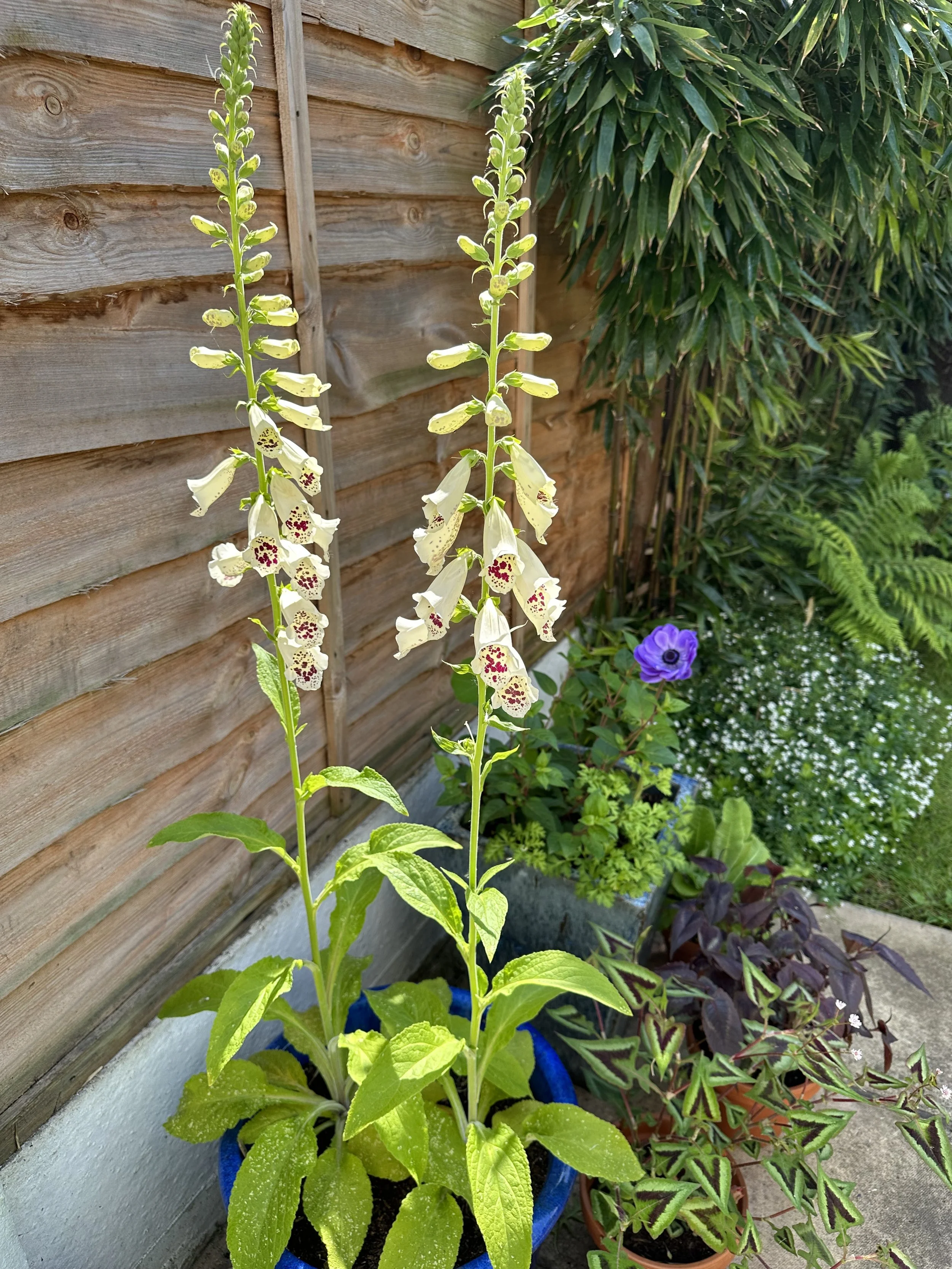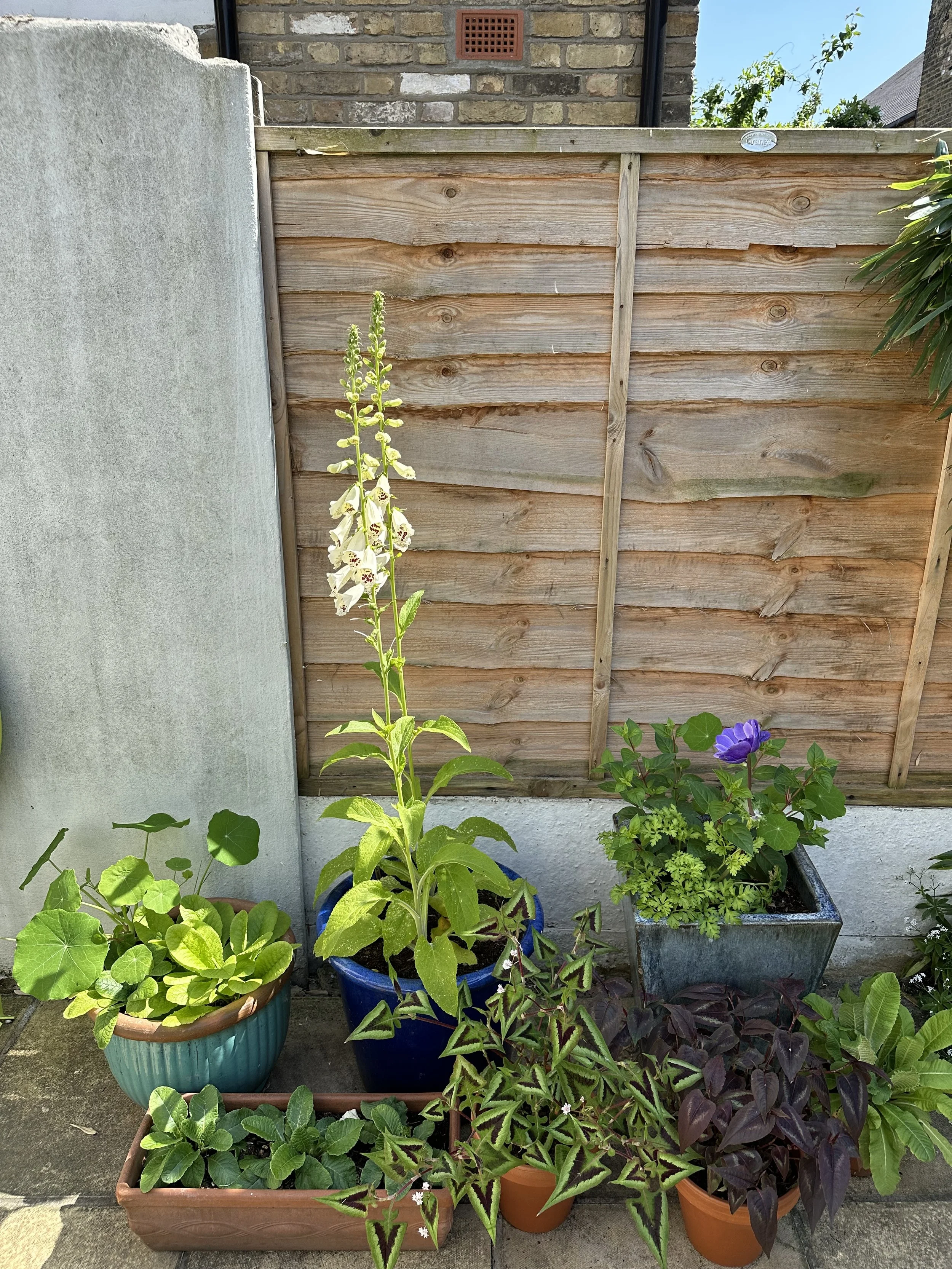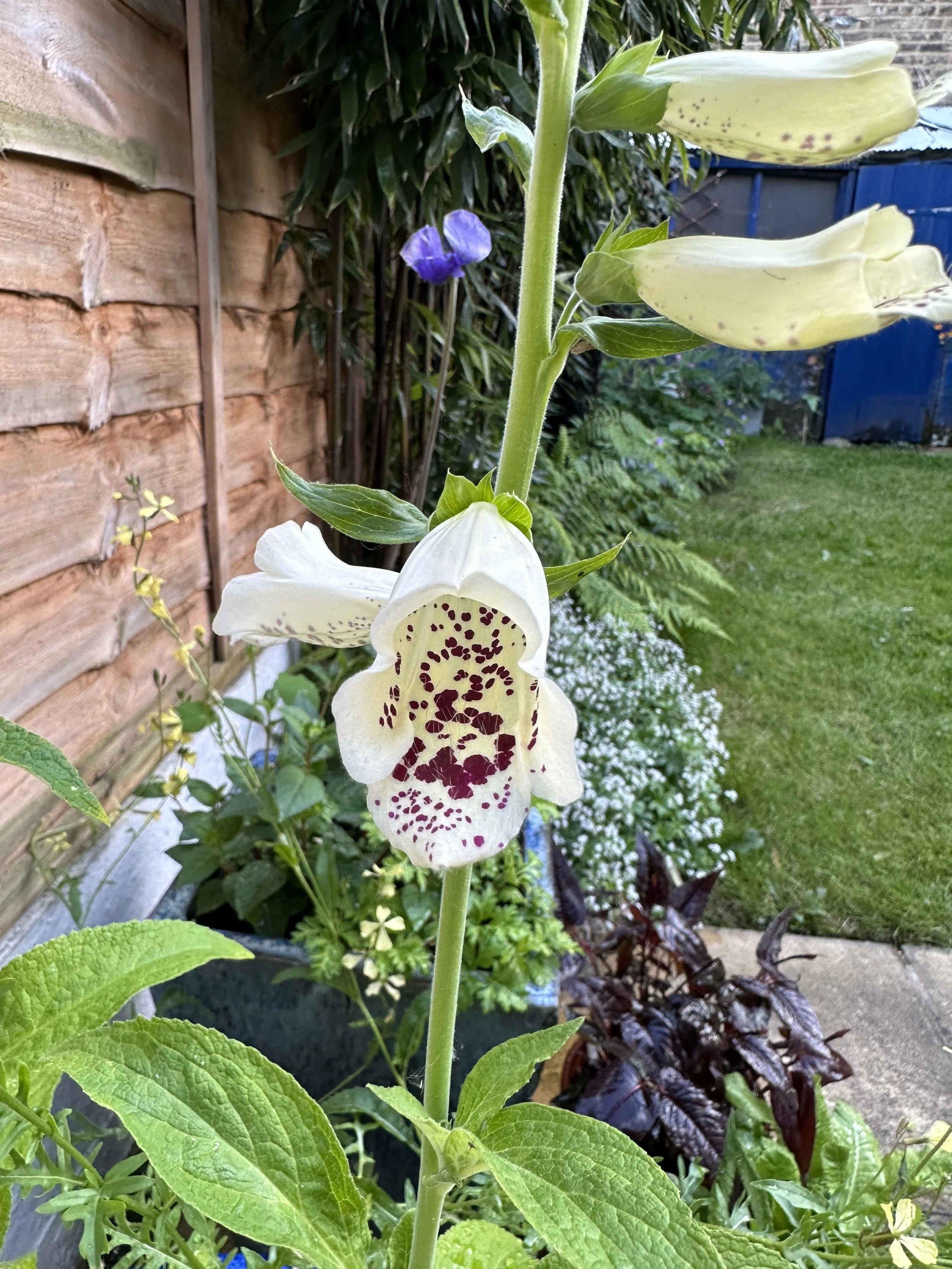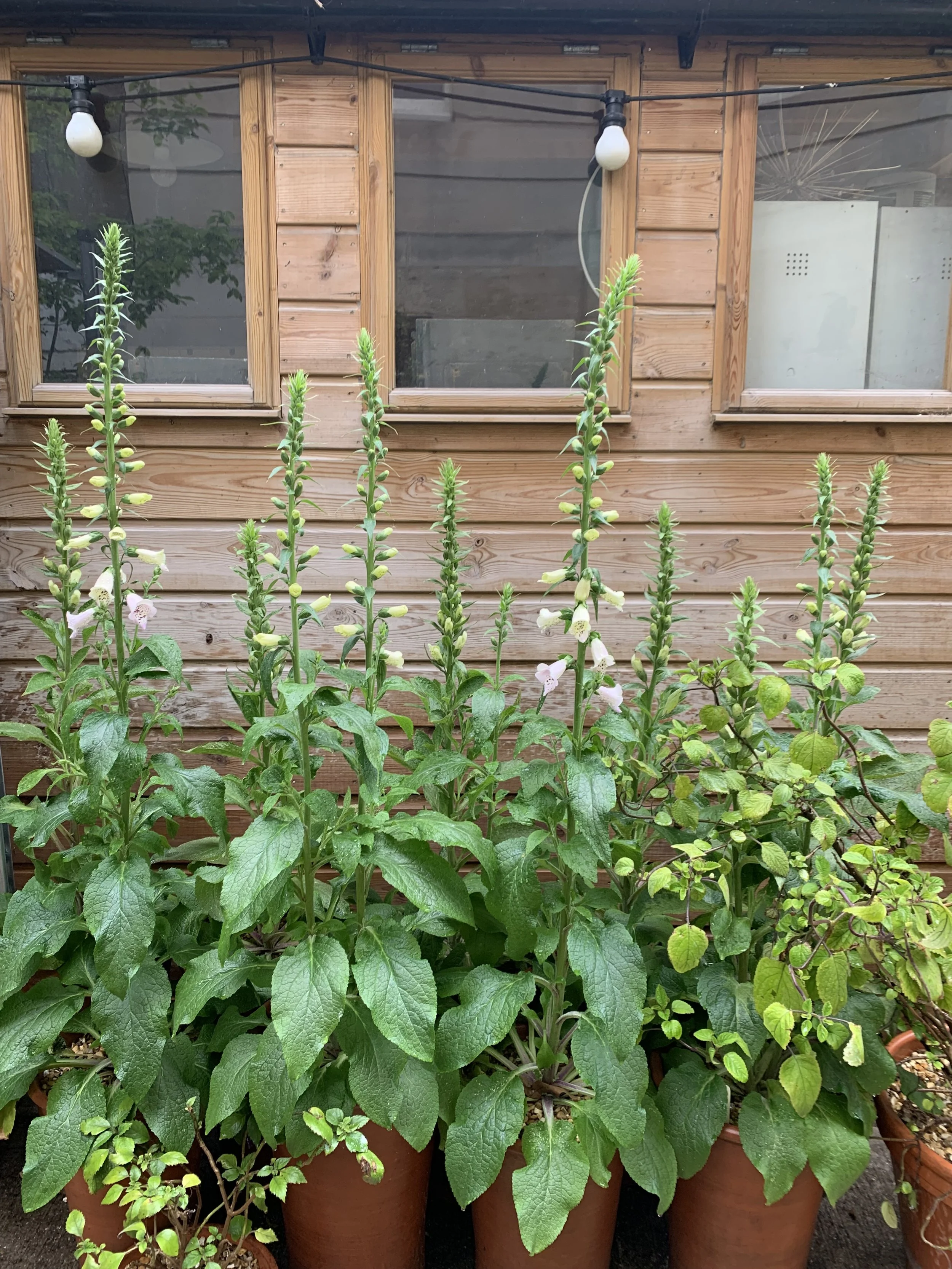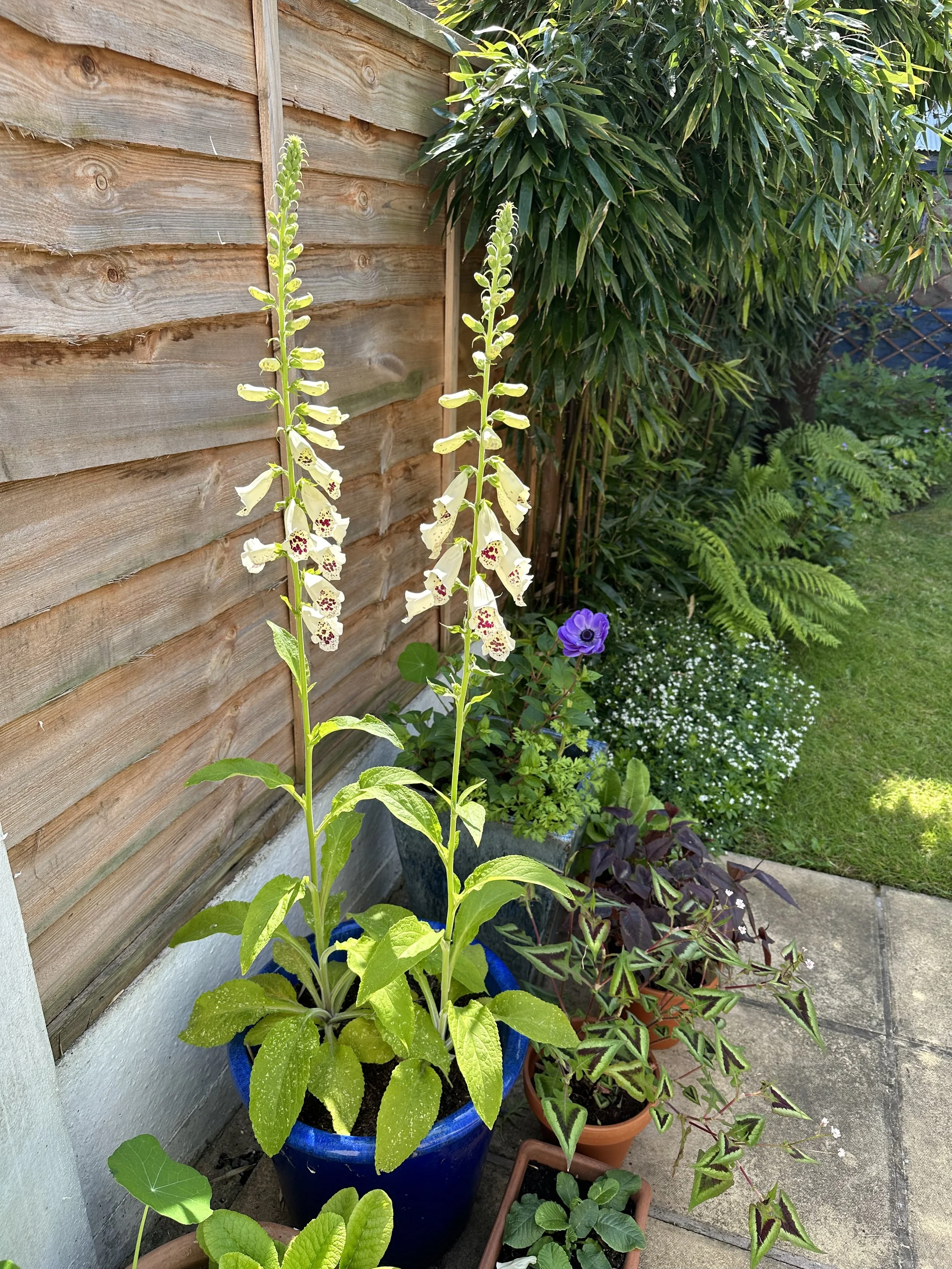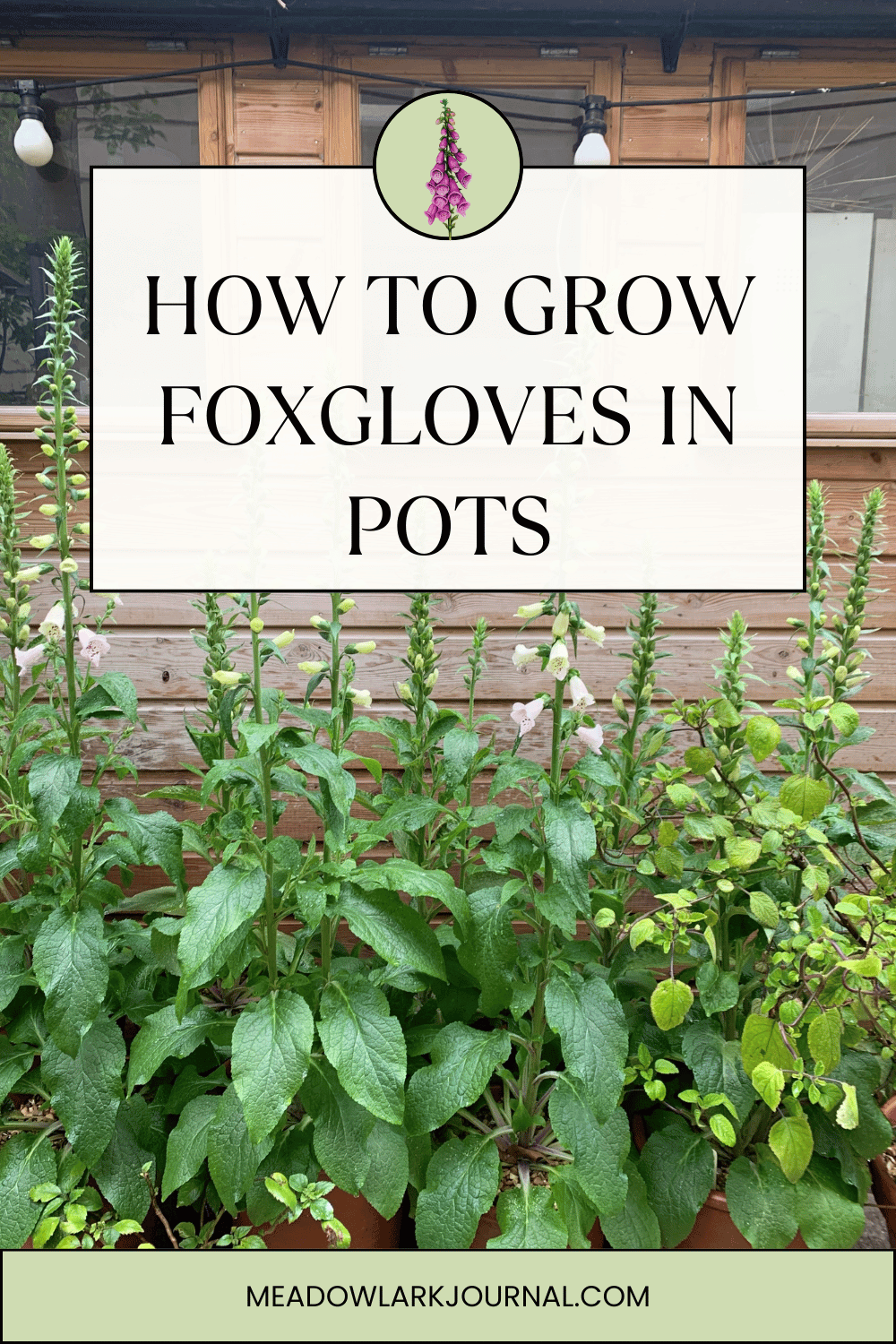Growing Foxgloves in Pots: An Easy Guide
This website is reader-supported - thank you! This post may contain affiliate links. As an Amazon Associate, I earn from qualifying purchases at no extra cost to you.
Growing foxgloves in pots is an art that combines the beauty of traditional English gardens with the practicality of modern container gardening.
Celebrated for their statuesque beauty at events like the Chelsea Flower Show, Digitalis purpurea and its perennial cousins bring an air of sophistication and charm to any setting.
This approach to gardening allows for the cultivation of foxgloves even in limited spaces, making it possible to enjoy their towering spikes and vibrant blooms without a sprawling garden.
Mastering foxglove care is important for anyone looking to sustain these captivating plants year after year.
Through this guide, I aim to equip you with the knowledge needed to nurture and flourish your foxgloves, ensuring that each pot becomes a showcase of beauty and elegance.
Foxgloves grow really well in northwest facing gardens.
To learn more about this, check out my guide Maximizing the Magic of North West Facing Gardens.
I love growing foxgloves in containers where they get dappled shade in the afternoon.
Choosing the Right Foxglove Variety for pots
The success of growing foxgloves in pots begins with selecting the right variety.
Foxgloves come in a range of species and cultivars, each with its own set of characteristics, blooming habits, and growing requirements.
Understanding these differences is key to choosing a variety that will not only thrive in a container environment but also meet your garden design goals.
Perennial vs. Biennial
Foxgloves are traditionally known as biennials, meaning they spend their first year growing foliage and bloom in their second year.
However, there are also perennial varieties that bloom year after year.
For container gardening, perennial foxgloves like Digitalis grandiflora offer long-term value as they don't need to be replanted annually.
Biennial varieties, such as the classic Digitalis purpurea, provide dramatic blooms and can be easily started from seed to ensure a continuous cycle of plants.
Size and Growth Habits
When choosing foxgloves for containers, consider their mature size and growth habit.
Some varieties can grow quite tall, which might be perfect for creating a vertical element in your garden display.
However, for smaller spaces or lower containers, compact varieties that reach a shorter stature might be more appropriate.
The size of the variety will also influence the size of the container needed to support healthy growth.
Sunlight and Shade Preferences
While foxgloves are often associated with woodland gardens and dappled shade, different varieties have varying light requirements.
Some thrive in full sun, while others prefer partial shade.
When growing foxgloves in containers, you have the flexibility to move them to achieve the perfect light conditions.
Choose a variety that matches the light availability in your intended location to ensure the health of your plants.
Flower Color and Form
Foxgloves are available in a spectrum of colors, from soft pinks and purples to bold yellows and whites.
The shape of the flower spikes and individual blooms can also vary.
Selecting a variety that complements your garden's color scheme and design can add a cohesive and stunning element to your container garden.
Hardiness and Durability
Consider the hardiness of the foxglove variety relative to your climate.
Some varieties are more tolerant of cold or heat than others.
For container-grown foxgloves, which can be more susceptible to extreme temperatures due to their above-ground location, choosing a variety suited to your climate can reduce the need for overwintering protection.
Want to learn more about growing flowers in pots? Check out my guides:
How to Grow Zinnias in Pots: From Seed to Colorful Blooms
Growing Vibrant Salvia in Pots
Digitalis ‘Camelot Creme’ growing in my container garden.
Start your own cut flower garden with my guide:
Noteworthy foxglove Varieties for pots
Some varieties of foxglove are better suited for pots than others due to their size, growth habit, and overall care requirements, making them more manageable and adaptable to the constraints of container gardening.
Here are the foxglove varities I recommend growing in pots:
Digitalis purpurea 'Dalmatian Peach'
A biennial or short-lived perennial that offers peach-colored blooms.
It is relatively compact, making it perfect for containers.
Here is the one I recommend growing:
Digitalis grandiflora
The yellow foxglove is a true perennial, offering pale yellow flowers and grows well in a variety of climates.
Here is the one I recommend growing:
Digitalis 'Camelot' Series
This series comes in several colors and tends to bloom in its first year, making it an excellent choice for those seeking quick and reliable flowering.
This is the variety I grew most recently and have featured in the photos in this article.
Here is the one I recommend growing:
Planting Your Foxgloves
Planting foxgloves in containers is a straightforward process that, when done correctly, sets the stage for healthy growth.
Whether you're planting foxglove seeds or plug plants, the right approach to planting can make all the difference.
grow foxgloves from seed
Timing:
The best time to start foxglove seeds for container growing is late winter to early spring if they are to be kept outdoors, or virtually any time if you can provide enough light indoors.
For a specific bloom season, consider that biennials bloom in their second year, while some perennials can bloom in their first year if started early.
Soil Preparation:
Use a high-quality potting mix that ensures good drainage while retaining enough moisture to keep the seeds hydrated.
Avoid garden soil as it can be too heavy and may introduce diseases.
To learn more about this, check out my guide Garden Soil vs. Potting Soil: How to Choose the Right One.
Here is the potting mix I recommend for growing foxgloves in containers:
Sowing the Seeds:
Foxglove seeds are tiny, so sprinkle them on the surface of the soil without covering them, as they need light to germinate.
Gently press the seeds into the soil with your fingers or the back of a spoon to ensure good contact.
Moisture and Warmth:
Keep the soil consistently moist but not waterlogged.
To learn more about this, check out my guide How Often to Water Seedlings.
Covering the pot with plastic wrap or a clear plastic dome can help retain moisture and warmth, speeding up germination.
To learn more about how to speed up germination, check out my guide The Ultimate Guide to Choosing the Best Electric Propagators.
Place the pot in a warm, bright spot but out of direct sunlight.
Thinning and Transplanting:
Once seedlings have developed their first set of true leaves and are large enough to handle, thin them out or transplant them to individual pots.
This gives each plant enough space to grow strong roots.
Starting With Plug Plants:
Choosing Your Container:
Select a pot at least 12-18 inches deep to accommodate the foxglove's taproot, ensuring it has adequate drainage holes.
Larger pots can accommodate multiple plants for a fuller display.
Soil and Planting:
Fill your container with a mix of potting soil and compost to provide a nutrient-rich environment.
Make a hole large enough for the plug plant's root ball, place the plant gently in the hole, and fill in around it with soil.
Water thoroughly to settle the soil around the roots.
Post-Planting Care:
Location:
Place your pot in a location that matches the light requirements of your chosen foxglove variety—full sun to partial shade, depending on the species.
Watering:
Keep the soil moist, especially during the first few weeks as the plants establish.
Once established, water whenever the top inch of soil feels dry to the touch.
For more watering tips and tricks, check out my guide How to Use Watering Globes.
Feeding:
Apply a balanced, slow-release fertilizer at the time of planting and follow up with liquid feed every 4-6 weeks during the growing season to support healthy growth and flowering.
Here is the fertilizer I recommend for foxgloves:
Tips for Success:
Acclimatization:
If you started your foxgloves indoors or bought them from a nursery, acclimatize them to outdoor conditions gradually over a week before planting them in their final outdoor spot.
Staking:
For taller varieties, consider staking early to support the flower spikes as they grow.
Mulching:
Applying a thin layer of mulch on the soil surface can help retain moisture and suppress weeds.
Here is the mulch I recommend:
Equip your urban green space with my recommend top tier tools.
Foxglove ‘Camelot Series’ with stunning white blooms and purple spots.
Foxglove Care in Pots
Caring for foxgloves in containers involves several key practices that differ slightly from in-ground cultivation, due to the unique conditions of container gardening.
By paying close attention to watering, feeding, positioning, and seasonal care, you can enjoy the full beauty of these stately blooms.
Watering
Proper watering is crucial for foxgloves in pots, as containers can dry out more quickly than garden soil.
However, it's equally important to avoid waterlogging, which can lead to root rot.
Check the soil moisture regularly, and water deeply when the top inch of soil feels dry to the touch.
During hot, dry periods, this may mean watering daily, while in cooler, cloudy weather, less frequent watering is required.
Ensure that your containers have good drainage holes to prevent excess water from accumulating.
Watering foxgloves is a great way to utilized rainwater collected in water butts.
Feeding
While foxgloves are not heavy feeders, container-grown plants benefit from regular nutrition due to the limited soil volume.
Apply a balanced, slow-release fertilizer at planting time to provide a steady supply of nutrients.
Additionally, supplement with a liquid feed every 4-6 weeks during the growing season to encourage robust growth and abundant flowering.
Be cautious not to over-fertilize, as this can lead to excessive foliage growth at the expense of blooms.
Positioning and Sunlight
Foxgloves thrive in a range of light conditions, from full sun to partial shade, depending on the variety.
Most foxgloves prefer the cooler conditions of morning sun and afternoon shade, particularly in hotter climates.
In containers, you have the advantage of moving plants to find the ideal spot that matches their light preferences.
This adaptability is especially useful as seasons change or if you notice signs of stress, such as wilting or sunscorch on the leaves.
Overwintering
Perennial foxgloves in pots require protection in colder climates to survive the winter.
Before the first frost, move containers to a frost-free but cool location, such as an unheated garage or shed, where they can go dormant without freezing.
Water sparingly, just enough to prevent the soil from completely drying out.
Come spring, gradually reintroduce the plants to outdoor conditions to avoid shock, and resume regular watering and feeding as growth resumes.
General Maintenance
Regularly inspect your foxgloves for signs of pests or disease, and address any issues promptly to prevent spread.
Deadheading spent blooms can encourage a second flush of flowers in some varieties and prevents self-seeding if desired.
For biennial varieties, after the second year's bloom, plants will typically die back.
You can collect seeds from these plants to sow for future blooms or allow them to self-seed in the container for a natural cycle of regeneration.
Repotting
Foxgloves grown as perennials may outgrow their containers or deplete the soil's nutrients over time.
Every two to three years, consider repotting into a slightly larger container with fresh potting mix to rejuvenate the plant and encourage continued growth and flowering.
By adhering to these care guidelines, your foxgloves will flourish in pots, bringing vertical interest, vibrant colors, and a touch of woodland charm to your patio, deck, or balcony garden.
The joy of watching these iconic flowers sway in the breeze, attracting bees and hummingbirds, is really rewarding.
For more flower garden tips, check out my guide:
Foxgloves grown in pots at Inner Temple Garden.
Why Grow Foxgloves in Pots?
Foxgloves (Digitalis spp.) stand as quintessential elements of the traditional cottage garden, yet their adaptability and grace have proven they belong in more than just expansive garden beds.
Growing foxgloves in pots offers a unique set of advantages that cater to both aesthetic and practical gardening needs.
Here's why container-grown foxgloves might just be the perfect addition to your gardening repertoire:
Versatility in Placement
Containers allow you to place foxgloves exactly where they're needed most, be it as a statement piece on a sunny patio, adding height to a mixed flower display, or brightening a semi-shaded corner of a small urban balcony.
This mobility is particularly useful for adjusting the plant's location based on sunlight needs as your garden evolves through the seasons.
Enhanced Disease and Pest Management
Growing foxgloves in pots can reduce the risk of soil-borne diseases and pest infestations.
Elevated from the ground, the plants are less susceptible to certain pests and fungal infections that proliferate in garden soil.
This controlled environment allows for healthier plants and more bountiful blooms.
Control Over Growing Conditions
Foxgloves thrive in well-draining soil with just the right amount of moisture — conditions that are easily managed in a container setting.
By choosing the appropriate soil mix and pot size, you can ensure optimal growing conditions that might be hard to achieve in open garden beds.
This is particularly advantageous for gardeners dealing with less-than-ideal soil conditions in their yards.
Extended Growing Season
In regions with colder climates, pots can be moved indoors or to a protected area to overwinter, extending the life of perennial varieties or safeguarding biennials until they bloom the following year.
This flexibility can lead to an extended growing season and early spring blooms, as plants can be moved back outside at the first sign of warm weather.
Architectural Interest and Height
Foxgloves are known for their dramatic spikes of bell-shaped flowers, which can add architectural interest and a sense of height to your garden composition.
When grown in pots, these striking features are elevated and can be more fully appreciated at eye level or as part of a tiered garden display.
Opportunity for Experimentation
Container gardening encourages experimentation with different varieties and combinations.
Foxgloves come in a range of colors and sizes, allowing for creative pairings with other plants.
Containers make it easy to experiment with these combinations without committing to a permanent spot in the garden.
Growing foxgloves in containers in my garden gives me flexibility to move the pot around to find the perfect growing spot.
FAQs
When to Sow Foxglove Seeds Indoors?
Sow foxglove seeds indoors 8-10 weeks before the last expected frost in your area.
To find the last expected frost date, this map by the Farmer’s Almanac is super useful.
This timing allows seedlings to grow strong enough to be transplanted outdoors once the danger of frost has passed.
Foxgloves require light for germination, so simply press the seeds into the surface of the soil without covering them.
Can I Sow Foxglove Seeds in September?
Yes, sowing foxglove seeds in September is an excellent strategy for gardeners looking to get a head start on the following spring.
This timing allows the plants to establish themselves before going dormant in the winter, ready to resume growth and bloom in spring.
This approach is especially useful for biennial varieties.
What to Do with Foxgloves After Flowering?
After foxgloves have flowered, you can deadhead the spent blooms to encourage a second flush of flowers in some varieties.
For biennials, once flowering is complete and the plant begins to die back, collect seeds for replanting or allow them to self-seed within the container.
Removing spent flower spikes can also help maintain a tidy appearance.
How Tall Do Foxgloves Grow in Pots?
The height of foxgloves in pots can vary based on the variety and container size, but many can reach up to 5 feet tall.
Dwarf varieties or those bred specifically for container gardening may stay shorter, around 2-3 feet in height, making them ideal for smaller spaces.
How Do You Care for Potted Foxglove?
Caring for potted foxglove involves ensuring they have well-draining soil, regular watering to keep the soil moist but not waterlogged, and feeding with a balanced fertilizer during the growing season.
Position the pot to match the light preferences of the variety, typically in a spot with morning sun and afternoon shade.
Overwinter perennials by moving pots to a sheltered location.
How Do You Keep Foxgloves Blooming All Summer?
To encourage foxgloves to bloom throughout the summer, deadhead spent flowers regularly to promote further blooming.
Ensure they receive adequate water and feed monthly with a liquid fertilizer high in phosphorus to encourage blooming.
Some varieties may naturally bloom longer into the summer, while others may require a second, staggered planting to extend the blooming period.
Does Foxglove Come Back Every Year?
Foxglove can be either biennial or perennial, depending on the variety.
Biennials typically bloom in their second year and then die, but they often self-seed, giving the appearance of coming back each year.
Perennial varieties, when properly cared for, will return year after year, blooming each season.
Do Foxgloves Need Sun or Shade?
Foxgloves perform best in partial shade, especially in areas with hot summers.
They can tolerate morning sun but appreciate protection from the intense afternoon heat.
The ideal location offers morning sunlight with dappled shade in the afternoon, mimicking their natural woodland environment.
Pin this post to save it for later!
